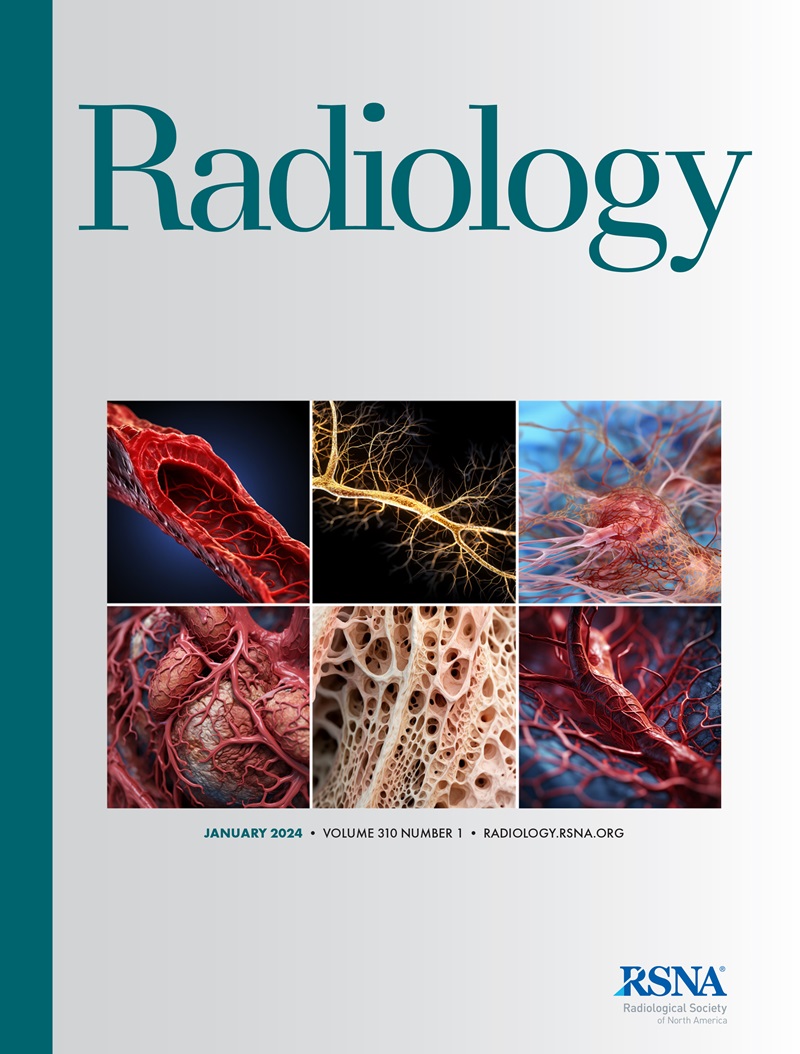心脏MRI评估长期暴露于环境空气污染与心肌纤维化的关系。
IF 15.2
1区 医学
Q1 RADIOLOGY, NUCLEAR MEDICINE & MEDICAL IMAGING
引用次数: 0
摘要
背景:空气质量差与心血管疾病有关。然而,潜在的病理生理机制尚不清楚。目的探讨长期暴露于空气动力学直径小于2.5µm的环境细颗粒物(PM2.5)与心脏MRI量化弥漫性心肌纤维化程度的关系。材料与方法在这项单中心回顾性研究中,纳入扩张型心肌病(DCM)患者或心脏MRI检查正常的对照组(2018年1月至2022年12月)。弥漫性心肌纤维化采用心脏MRI原生T1映射z评分进行量化。使用最近监测站的直接测量结果,将特定住所的环境PM2.5浓度评估为心脏MRI前一年的每日暴露浓度平均值。对多变量模型进行临床相关协变量调整。结果共694例患者(平均年龄47岁±16岁);443人;纳入DCM组493例,对照组201例。在多变量模型中,1年平均PM2.5暴露量每增加1µg/m3, DCM患者的原生T1 z评分就会提高0.30(调整后的β系数:0.30;95% ci: 0.13, 0.47;P < 0.001),对照组T1 z评分高0.27(校正β系数:0.27;95% ci: 0.04, 0.51;P = .02)。就绝对值而言,1年平均PM2.5暴露量每增加1µg/m3,在1.5 T时,原生T1升高9.1 msec (β系数:9.1;95% ci: 2.04, 15.97;P = 0.01),并且在3t时比原始T1高12.1 msec (β系数:12.1;95% ci: 5.74, 18.52;P < 0.001)。分层模型显示,PM2.5暴露与女性原生T1 z评分之间的关联效应最大(β系数:0.49;95% ci: 0.23, 0.76;P < 0.001),吸烟者(β系数:0.43;95% ci: 0.02, 0.84;P = .04),高血压患者(β系数:0.48;95% ci: 0.16, 0.80;P = .004)。结论在DCM患者和健康对照者的心脏MRI原生T1定位中,较高的长期暴露于环境细颗粒物污染与更大的弥漫性心肌纤维化有关。©RSNA, 2025另见Vigneault在本期的社论。本文章由计算机程序翻译,如有差异,请以英文原文为准。
Association between Long-term Exposure to Ambient Air Pollution and Myocardial Fibrosis Assessed with Cardiac MRI.
Background Poor air quality is associated with cardiovascular morbidity. However, the underlying pathophysiologic mechanisms are unclear. Purpose To determine the relationship between long-term exposure to ambient fine particulate matter with 2.5-µm or smaller aerodynamic diameter (PM2.5) and the extent of diffuse myocardial fibrosis quantified with cardiac MRI. Materials and Methods In this single-center retrospective study, patients with dilated cardiomyopathy (DCM) or controls with normal cardiac MRI findings were included (January 2018 to December 2022). Diffuse myocardial fibrosis was quantified using cardiac MRI native T1 mapping z scores. Residence-specific ambient PM2.5 concentration was assessed as the mean of daily exposure concentration in the year before cardiac MRI using direct measurements from the nearest monitoring station. Multivariable models were adjusted for clinically relevant covariates. Results A total of 694 patients (mean age, 47 years ± 16 [SD]; 443 men; 493 with DCM, 201 controls) were included. In multivariable models, each 1-µg/m3 increase in 1-year mean PM2.5 exposure was associated with a 0.30 higher native T1 z score in patients with DCM (adjusted β coefficient: 0.30; 95% CI: 0.13, 0.47; P < .001) and 0.27 higher native T1 z score in controls (adjusted β coefficient: 0.27; 95% CI: 0.04, 0.51; P = .02). For absolute values, each 1-µg/m3 increase in 1-year mean PM2.5 exposure was associated with 9.1 msec higher native T1 at 1.5 T (β coefficient: 9.1; 95% CI: 2.04, 15.97; P = .01) and 12.1 msec higher native T1 at 3 T (β coefficient: 12.1; 95% CI: 5.74, 18.52; P < .001). Stratified models indicated the largest effect sizes for the association of PM2.5 exposure with native T1 z scores in women (β coefficient: 0.49; 95% CI: 0.23, 0.76; P < .001), smokers (β coefficient: 0.43; 95% CI: 0.02, 0.84; P = .04), and patients with hypertension (β coefficient: 0.48; 95% CI: 0.16, 0.80; P = .004). Conclusion Higher long-term exposure to ambient fine particulate air pollution is associated with greater diffuse myocardial fibrosis at cardiac MRI native T1 mapping in patients with DCM and healthy controls. © RSNA, 2025 See also the editorial by Vigneault in this issue.
求助全文
通过发布文献求助,成功后即可免费获取论文全文。
去求助
来源期刊

Radiology
医学-核医学
CiteScore
35.20
自引率
3.00%
发文量
596
审稿时长
3.6 months
期刊介绍:
Published regularly since 1923 by the Radiological Society of North America (RSNA), Radiology has long been recognized as the authoritative reference for the most current, clinically relevant and highest quality research in the field of radiology. Each month the journal publishes approximately 240 pages of peer-reviewed original research, authoritative reviews, well-balanced commentary on significant articles, and expert opinion on new techniques and technologies.
Radiology publishes cutting edge and impactful imaging research articles in radiology and medical imaging in order to help improve human health.
 求助内容:
求助内容: 应助结果提醒方式:
应助结果提醒方式:


